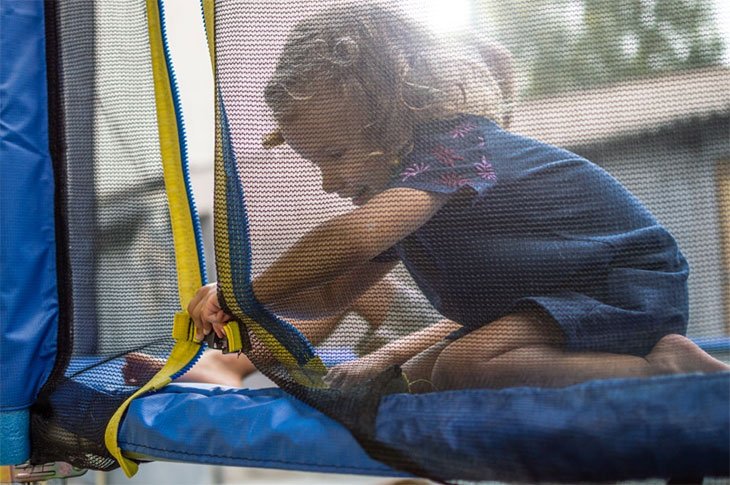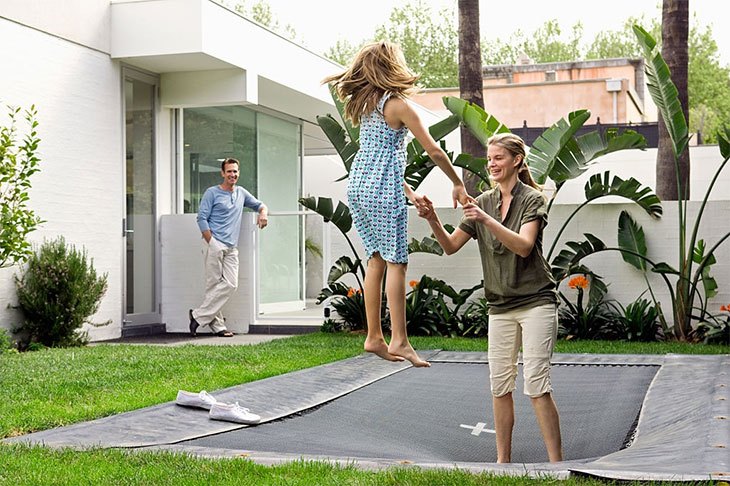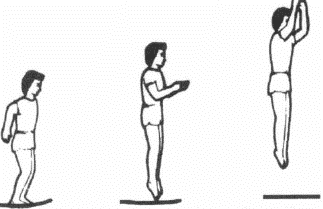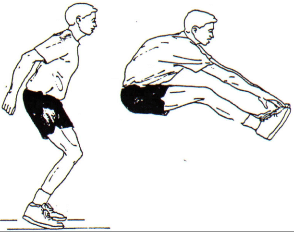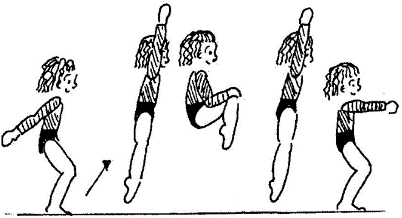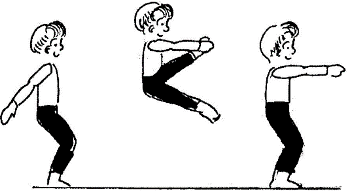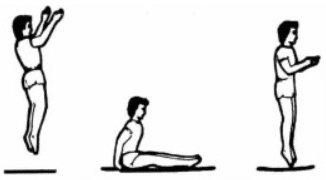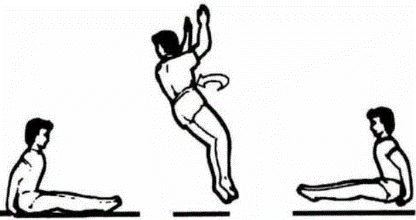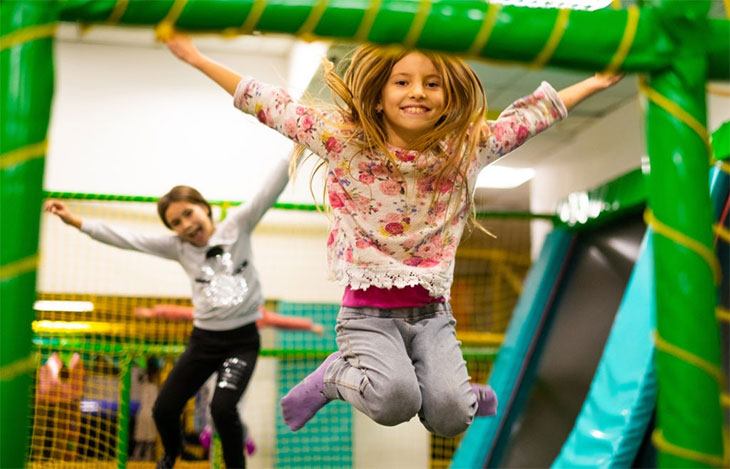Scraps, bruises, arm/leg/skull fractures, and head injuries are all on a list of things that you want to avoid as a direct consequence of owning and playing on a trampoline.
While having a trampoline in your backyard is a great source of exercise and excitement, both for children and adults, the other, not-so-fun side should never be ignored.
Most of the trampoline-induced injuries stem from easily preventable situations and accidents, such as irregular positioning of the trampoline, colliding, falling off the trampoline, not having a safety net… You name it.
Improper use of the trampoline can and should be avoided at all costs.
Instead of looking at a trampoline as a potential gateway to danger, educate yourself and pick up some useful safety tips for playing on a trampoline so that you can enjoy this activity with your family.
Keep reading this article to find out all of the safety measures that you can take to claim back this fun and active toy for you and your children.
More...
Key Features and Necessary Equipment
So, you decided to buy a trampoline that you and your family can enjoy. Can you just buy any trampoline? Is there anything that you should be on the lookout for?
These are all the questions that are frequently posed when it comes to shopping for a trampoline.
It is of utmost importance that you do extensive research before you make the purchase.
Trampolines and their designs have changed over the course of the years, and they are far from being a hazardous toy that they used to be.
Here are some things that you should take into consideration before buying a trampoline:
1. Safety Net
It is common knowledge that most injuries result from jumpers and bouncers falling off the trampolines.
One of the most important aspects and a key feature of a safe jumping environment is having a safety net to enclose the trampoline with.
However, not all trampolines are sold with safety nets, so before making a purchase, make sure that your ideal trampoline comes along with one. Or if it doesn’t, make sure you invest in one!
2. Safety Pads
Believe it or not, some trampoline models are sold without safety pads.
Safety pads are critical to the safety of any bouncer that comes on the trampoline. If left uncovered, springs could be dangerous.
To prevent this, purchase a trampoline model that has pre-installed safety pads or purchase safety pads separately and cover the springs on your trampoline.
3. Sturdy Frame
The core of your trampoline should be both strong and secure.
Make sure to avoid trampolines with frames that have sharp edges, as that is an obvious safety hazard and should be avoided at all costs.
Models with sharp edges and frames which are connected to the jumping areas are not a good idea.
Instead, look for models that offer a sleek design and a sturdy frame that will not be accessible to the bouncer.
Establish the Rules
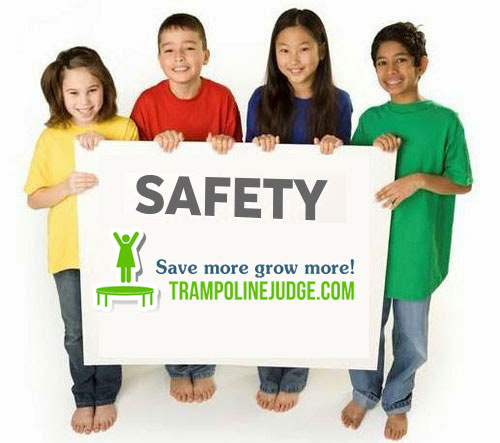
First things first: if you have children, make sure that they know that using the trampoline without adult supervision is out of the question.
Nowadays, children are exposed to a lot of influences, especially on the Internet - and seeing videos of people performing crazy tricks on YouTube is something that they have possibly encountered before.
Recreating these tricks and trying to perform them can have lasting, if not permanent, effects on a child’s health and wellbeing. For that, make sure that they understand that they cannot use the trampoline without adult supervision.
Another common factor that contributes to injuries is more than one person being on a trampoline at a time.
Bouncing can be tricky when there are more people on a trampoline, so collisions and injuries are more likely to happen.
As it was mentioned before, performing stunts, backflips, somersaults should be ruled out as well. Gymnastic exercises should never be permitted on a trampoline, as children (and adults!) can easily lose control and injure themselves.
Getting off the trampoline should be regulated, as well. Jumping off the trampoline is not only dangerous but also reckless.
Make sure that you always use the ladder, or to simply exit the trampoline by doing this: stopping the bouncing, sitting down and sliding ff.
If you regulate the way the trampoline is used, there is virtually nothing that could go wrong when rules are followed.
Remember the safety rules for adventure to walk away safe
Secure the Area
The position of the trampoline is important. Choosing the safest and most appropriate area is of utmost importance. You will need to do the following:
Once your area is safe and sound, you can play on your trampoline as much as you’d like, without the fear that something might happen.
Appropriate Attire
People tend to overlook the part of clothes in using the trampoline, mostly because they do not want to overthink a joyous time that playing is and should be.
But, there are considerable disadvantages to not wearing the appropriate attire when playing on a trampoline, the most serious among them being injuries.
The majority of clothes that children wear have drawstrings, which seems innocent enough, right?
These are easily intertwined when it comes to jumping and bouncing on a trampoline.
They can get into net holes. They can get stuck virtually everywhere which might result in an uncomfortable landing; thus it can lead to potentially grave injuries.
Jewelry is another important factor that can cause or lead to injuries. If you or your children wear any kind of jewelry, you should keep in mind to remove it every time you want to use the trampoline.
What to Do Before Getting On a Trampoline?
If your trampoline is located in your backyard, chances are that you or your children use that location for a lot of things.
Children mainly play and run free in the backyard, and for that reason, you must always check underneath your trampoline.
Objects and toys frequently get misplaced, and if there are objects underneath your trampoline when you or your children mount it, it can lead to injuries. Therefore, don’t forget to check what is under the trampoline before using it.
Safety Suggestions For All Kids
People will not stop buying trampolines for their kids. Follow these no-nonsense ideas to make jumping on trampolines safer. Injuries happen most often when there are multiple jumpers because they can collide with each other or catapult one another off the trampoline.
The average kid can jump 8- to 10-feet and that is very high. Falling off a raised trampoline could be a 13-foot fall that can cause severe injuries when they bounce off. Be sure to have your trampoline on a soft area such as grass and never have it on stones or sand.
Be sure to check the mat, supporting bars, and rigging for damage and wear. Make sure you can see the kids on the trampoline from inside your house.
Make sure the trampoline is secure from wind because heavy winds can blow them over. It might be a good idea to secure the trampoline in place.
Exercises For Basic Level Beginners
1. Straight Jump: Body straight, arms above head, jump straight up (vertically) for taking off.
2. Pike Jump: Legs are straight ahead of you parallel to the trampoline mat at about 90-degrees, arms, and body bend at waist to toes you can touch.
3. Tuck Jump: Knees pulled up to the chest and hands briefly hold the legs between the ankle and the knee before landing on the trampoline mat.
4. Straddle Jump: Similar to straight jump but legs are spread open 90-degrees then return to a standing position.
5. Seat Drop: Land you butt on the mat seated with legs straight and arms at side of body, palms down, finger tips forward.
6. Swivel Hips: Do the seat drop, above, bounce up but do not land, turn around half-way, 90-degrees, and do a seat drop facing the opposite direction.
7. Half Twist: Do a vertical straight jump and turn 180-degrees before landing.
8. Full Twist: Do a vertical straight jump and turn 360-degrees before landing.
The above exercises should be done only with adult supervision with only 1 person using the trampoline at a time. The spotter(s) should stand at the side of the trampoline.
In the competitive sport of trampolines, somersaults are performed in 3 shapes of tuck, pike, and straight and can be performed either forwards, backwards or sideways.
Somersaults should never be performed on a backyard trampoline due to the high risk of head and neck injuries.
And Most Importantly: Have Fun!
Now that you are familiar with what you should and shouldn’t do on a trampoline, you are ready to go and have some fun.
Accidents and injuries can be a thing of the past because now:
Remember, trampolines are intended to be a fun and fulfilling family activity, not a toy that you can look at with contempt and fear. For your and the safety of your family, make sure that you never use the trampoline under the influence of alcohol and narcotics.
Play safely!
My name is Larry Dunn from Dallas Texas and I have a deep passion and love for the trampoline.
With many years of experience in the field of healthcare service, I have decided to start his own website which is about a trampoline.
With this website, I will share his experiences and expertise advices on different factors to consider when deciding whether or not a trampoline is safe for you and your family.

